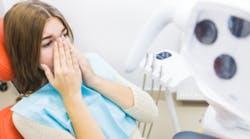Practice Changers: Gingicaine
Amber Auger, MPH, RDH
When it comes to scaling, I am burnished calculus’s worst nightmare. I find few things as rewarding as removing calculus that has been hiding under the patient’s gums. As dental professionals, we know that the burnished calculus can lead to periodontal disease. Over the last few years, I have found an increasing amount of residual subgingival calculus that is often burnished. I attribute this to improper technique, neglecting to implement an 11/12 explorer, improper working ends, reduced clinical time, and well-intentioned concern for patient comfort. With the intention of not becoming the “mean hygienist” in the office, I began my pursuit of finding a topical anesthetic. My research led me to Gingicaine, an anesthetic gel that works quickly, tastes great, and patients love.
Overview
• Active ingredient: 20% benzocaine gel
• Uses: Reduce pain or discomfort caused by minor dental procedures, minor gum injuries, canker sores, and minor mouth or gum irritations caused by dentures or orthodontic appliances.1
• Contraindications: Should not be used in patients with history of hypersensitivity to ester-like anesthetics, or on severely traumatized mucosal areas that are infected. Do not use on patients who are allergic to “-caine” anesthetics or FD&C Red 40.1
• Ordering: Gingicaine can be ordered through major distributors and comes in a strawberry-flavored gel. Gingicaine gel syringesare available in kits containing 20 syringes each with 1.2 mL of benzocaine gel and 40 micro needle tips.
Application process
The gel is dispensed through a syringe that has disposable application tips that are similar depth and circumference as a probe. The tip is round to prevent trauma to the sulcus and eliminate “poking” during the delivery. Pink in color, the gel is easy to identify when placing it along the sulcus. Gingicaine flows smoothly and does not “ooze” to other locations in the mouth. For best results, the gingiva should be dried prior to application; the use of the saliva ejector will help to prevent excess saliva from diluting the gel.
Patient perception
Patients find the taste to be pleasant, unlike some other anesthetics. The quick onset time of 15 to 20 seconds allows the patient to feel comfortable with scaling almost immediately. The patient feels comfortable even when you are removing debris around inflamed or recessed tissue. Additionally, the ease of use allows the clinician to promptly apply as needed, without having to disturb the patient or the flow of the appointment. The product worked well for scaling and root planing on patients that declined local anesthetic, and I treated five patients with 5 mm to 6 mm pockets without patient discomfort.
I have found great success using Gingicaine, and it has become one of my most reliable chairside tools that helps me to effectively treat my patients without causing pain. The simple application process and positive patient perception has kept both patient and provider happy. I have even used this on canker sores or prior to laser procedures. I can now be effective without inducing pain!
Reference
1. Gingicaine Gel Strawberry. Drugs.com website. https://www.drugs.com/otc/550502/gingicaine-gel-strawberry.html. Accessed January 2, 2019.
Amber Auger, MPH, RDH, is a practicing dental hygienist and clinical innovations implementation specialist. With over 14 years of experience in the dental industry, Amber provides customized protocols to allow the practice to thrive, refocuses on the patient experience, and utilizes systemic approaches to periodontal therapy. Amber can be reached at [email protected].
